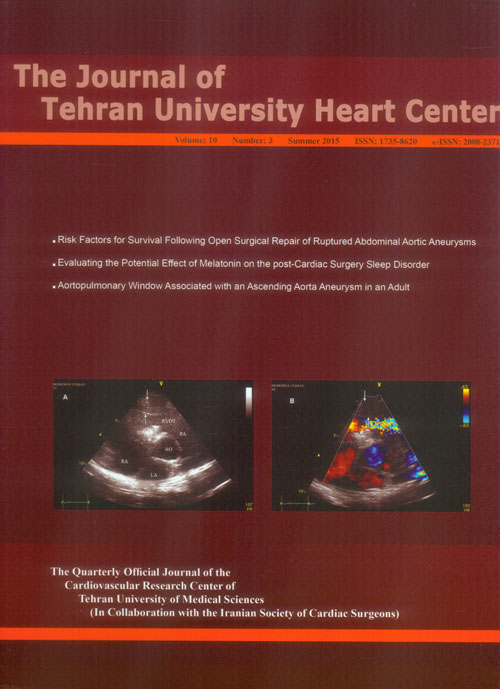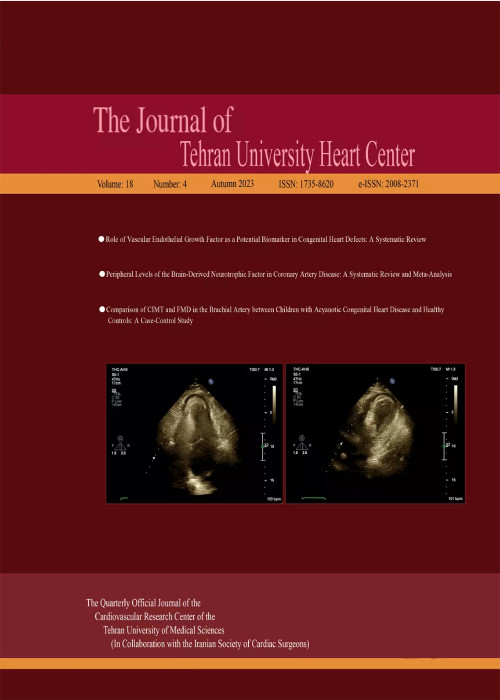فهرست مطالب

The Journal of Tehran University Heart Center
Volume:10 Issue: 3, Jul 2015
- تاریخ انتشار: 1394/05/21
- تعداد عناوین: 11
-
-
Pages 117-121BackgroundSurgical treatment of a ruptured abdominal aorta aneurysm (RAAA) continues to present a significant challenge to surgeons. There are some patient factors such as age and gender that cannot be changed, and comorbid conditions can be optimized but not eliminated. The purpose of this study was to identify the risk factors affecting high mortality after the surgical repair of an RAAA.MethodsData on 121 patients who underwent surgical repair for RAAAs between January 1997 and June 2011 in our institution were collected retrospectively. All the patients had been diagnosed by computed tomography (CT) scans, and intraoperative extra-luminal blood was visualized intraoperatively. Variables studied comprised demographic data; preoperative, operative, and postoperative data; and the causes of mortality. Multivariate regression analysis was used to determine the predictors of mortality.ResultsOne hundred eight (89.2%) patients were male and 13 (10.7%) were female at an average age of 68.9 ± 10.5 years. Totally, 121 patients underwent surgery for RAAAs. Fifty-four patients had aortic tube grafts, 32 aortobiiliac grafts, 20 aortobifemoral grafts, 1 aortoiliac graft, and 1 aortofemoral graft for the replacement of the RAAAs. Seven patients had only surgical exploration. Operative mortality was 41.3% (50 patients). The factors associated with mortality were preoperative shock, free blood, positive inotropic agent, hematocrit value, and need for blood and plasma. In the multivariate analysis, preoperative shock and positive inotropic agents were found to be significant as the predictors of death (OR: 19.8, 95%CI: 3.2-122.8 and OR: 8.6, 95% CI: 2.9-26.3, respectively).ConclusionThis study revealed that the preoperative clinical findings affected the mortality associated with RAAAs.
-
Pages 122-128BackgroundPostoperative neurological injuries, including cognitive dysfunction, sleep disorder, delirium, and anxiety, are the important consequences of coronary artery bypass graft surgery (CABG). Evidence has shown that postoperative sleep disturbance is partly due to disturbed melatonin secretion in the perioperative period. The aim of this study was to evaluate the effect of melatonin on postoperative sleep disorder in patients undergoing CABG.MethodOne hundred forty-five elective CABG patients participated in a randomized double-blind study during the preoperative period. The patients were randomized to receive either 3 mg of melatonin or 10 mg of Oxazepam one hour before sleep time. Each group received the medication from 3 days before surgery until the time of discharge. Sleep quality was evaluated using the Groningen Sleep Quality Score (GSQS), and the incidence of delirium was evaluated by nursing records. Sleep quality and anxiety scores were compared before and after surgery through the Wilcoxon signed-rank test. The analysis of covariance (ANCOVA) and independent t-test were used to compare the sleep and anxiety scores between the groups. P values ≤ 0.05 were considered statistically significant.ResultsTotally, 137 patients at a mean age of 60 years completed the study (76% male). The analysis of the data showed that sleep was significantly disturbed after surgery in both groups. The patients in the Oxazepam group demonstrated significantly higher disturbance in their mean postoperative GSQS score than did their counterparts in the melatonin group (p value < 0.001). A smaller proportion of the participants experienced delirium in the melatonin group (0.06%) than in the Oxazepam group (0.12%); however, this difference was not statistically significant.ConclusionThe result of the present study revealed that melatonin improved sleep in post-cardiac surgery patients more than what was observed with Oxazepam. Therefore, melatonin may be considered an effective alternative for Benzodiazepines in the management of postoperative sleep disorder.
-
Pages 129-133BackgroundCoronary artery bypass graft surgery (CABG) improves the quality of life, increases survival, and influences the patient''s mental and emotional aspects. Little information is available on the lived experience of Iranian patients after this surgery. Understanding the lived experiences of patients will help health professionals with better provision of high quality care.MethodsThis hermeneutic phenomenological study aimed to understand the lived experience of patients after CABG. Van Manen''s method was used to conduct the study. A semi-structured, face-to-face interview technique was employed to explore the experiences of the patients following surgery. Seven men and 4 women between 49 and 80 years old were interviewed.ResultsPassion for life was the main theme extracted from the participants’ interviews. This theme comprised the three sub-themes of receiving attention from family, being hopeful, and being spiritually oriented.ConclusionThe results showed that the participants experienced passion for life after their surgery. This finding reveals that patients tend to find a new perspective on life and their health after surgery.
-
Pages 134-139BackgroundInjured phrenic nerve secondary to cardiac surgeries is the most common cause of diaphragmatic paralysis (DP) in infants. The aim of this study was to determine the risk factors for DP caused by congenital heart defect corrective surgeries in pediatrics.MethodsThis cross-sectional study, conducted in a 2-year period (2006–2008), included 451 children with congenital heart diseases admitted to the Pediatric Cardiac Surgery Ward of Imam Khomeini Hospital. The diaphragmatic function was examined via fluoroscopy, and the frequency of DP and its relevant parameters were evaluated.ResultsOf the 451 patients, comprising 268 males and 183 females at an age range of 3 days to 204 months (28.2 ± 33.4 months), 25 (5.5%) infants (60% male and 40% female, age range = 15 days to 132 months, 41.2 ± 28.1 months) had DP as follows: 48% unilateral right-sided and 36% unilateral left-sided. Additionally, 68% had cyanotic congenital heart disease and 84% had DP following total correction surgery. The highest prevalence rates of DP resulting in phrenic hemiparesis were observed after arterial switch operation, Fontan procedure, and Blalock–Taussig shunt surgery, respectively. Thirteen (52%) of the 25 DP patients underwent surgical diaphragmatic plication because of severe respiratory distress and dependency on mechanical ventilation, and most of the cases of plication underwent arterial switch operation. The rate of mortality was 24% (6 patients).ConclusionDP with a prevalence of 5.5% was one of the most common complications secondary to cardiac surgeries in the infants included in the present study. Effective factors were age, weight, cyanotic congenital heart defects, and previous cardiac surgery. Diaphragmatic plication improved prognosis in severe cases.
-
Pages 140-148BackgroundHealthy lifestyle and ineffective coping strategies are deemed significant variables among patients with hypertension. This study attempted to determine the status of these variables following intervention via the mindfulness-based stress-reduction program (MBSRP) in patients with hypertension.MethodThis study was a randomized clinical trial. The study sample, consisting of 30 patients referring to the Hypertension Clinic of Imam Hossein Hospital in 2013, was assigned either to the intervention (recipient of the MBSRP and conscious yoga) or to the control group (recipient of yoga training). The intervention group had 8 training sessions over 8 weeks. Lifestyle and coping strategies as well as blood pressure were measured in the intervention group before intervention and then immediately thereafter and at 2 months'' follow-up and were compared to those in the control group at the same time points.ResultThe mean age of the patients in the intervention (40% women) and control (53% women) groups was 43.66 ± 5.14 and 43.13 ± 5.04 years, respectively. The results showed that the mean scores of lifestyle (p value < 0.05), emotion-focused coping strategies (p value < 0.001), problem-focused coping strategies (p value < 0.001), diastolic blood pressure (p value < 0.001), and systolic blood pressure (p value < 0.001) were significantly different between the intervention and control groups after the intervention.ConclusionApplying an intervention based on the MBSRP may further improve the lifestyle and coping strategies of patients with hypertension.
-
Pages 149-151Today, congenital heart diseases may be treated without surgery through advances in interventional cardiology. However, complications such as infection and thrombus formation may develop due to foreign materials used during these procedures. Surgical intervention may be required for the removal of the device utilized for the procedure. In this case report, we present the surgical treatment of a residual ventricular septal defect (VSD) that had developed in a 6-year-old patient with an apical muscular VSD closed with the Amplatzer muscular VSD device. The patient was admitted to the emergency room with complaints of abdominal pain and high fever 5 days after discharge without any cardiac symptoms. When she arrived at our clinic, she had a heart rate of 95 bpm, blood pressure of 110/70 mmHg, and temperature of 38.5ºC. Examinations of the other systems were normal, except for a 3/6 pan-systolic murmur at the mesocardiac focus on cardiac auscultation. Echocardiography showed a residual VSD, and the total pulmonary blood flow to the total systemic blood flow ratio (Qp/Qs) of the residual VSD was 1.8. In the operating room, the Amplatzer device was removed easily with a blunt dissection. The VSD was closed with an autologous fresh pericardial patch. Following the pulmonary artery debanding procedure, the postoperative period was uneventful. The condition of the patient at the time of discharge and in the first postoperative month’s follow-up was good. There was no residual VSD or infection.
-
Pages 152-155Total anomalous pulmonary venous connection (TAPVC) is an anomaly in which the pulmonary veins are directly connected to one of the systemic veins or drain into the right atrium. Management of pulmonary hypertension after the total correction of this congenital cardiac anomaly is very important. Unligation of the vertical vein in the supracardiac type of this anomaly can be a draining pathway for the prevention of postoperative pulmonary hypertension crisis. Late onset transcatheter closure of the unligated vertical vein after a decrease in pulmonary pressure with the Amplatzer vascular plug type 1can prevent residual left-to-right shunting. Here we describe two patients who previously underwent surgical correction of supracardiac TAPVC and their vertical veinwas partially ligated due to severe pulmonary hypertension. Consequently, because of increased left-to-right shunting in the follow-up period, transcatheter occlusion of the vertical vein was done for them and this procedure seemed safe and less invasive compared to the surgical approach.At 2 years''follow-up, there was marked pulmonary artery pressure and clinical improvement.
-
Pages 156-158Aortopulmonary window (APW) is a rare congenital malformation. It results from an incomplete division between the ascending aorta and the pulmonary artery. We describe a 26-year-old male, who presented with a grade II exertional dyspnea and palpitations. Echocardiography revealed an APW with an ascending aorta aneurysm. He underwent surgery under cardiopulmonary bypass without aortic cross-clamping. The APW was closed via the pulmonary artery flap technique using an autologous pericardial patch, and the aneurysm was repaired through the reduction aortoplasty technique. The patient was discharged on the 4th postoperative day. At 2 years'' follow-up, he had remained asymptomatic and echocardiography showed aortic valve competence, ascending aorta diameter of 38 mm, and no residual shunt.
-
Pages 159-162Spontaneous coronary artery dissection (SCAD) is a rare and important cause of acute coronary syndrome and sudden cardiac death. Various etiologies are thought to be responsible for this condition, among which underlying atherosclerosis seems to be the most common. SCAD is predominant in women and is usually diagnosed via coronary artery angiography. Therapeutic interventions include medical therapy, percutaneous coronary artery intervention, and surgery based on lesion characteristics. We describe a 36-year-old woman with SCAD presenting with acute chest pain to Fatemeh-Zahra Hospital, Sari, Iran. The patient had no current atherosclerosis risk factors and had given birth 6 months previously. Coronary angiography was performed due to the persistence of the chest pain after initial management, and a spontaneous dissection of the left anterior descending artery was observed. She underwent coronary artery bypass graft and was discharged in good condition.
-
Pages 163-164We present an old man with toe nail deformity and hypertrophy, diagnosed as onychogryphosis or Ram’s horn nail.


